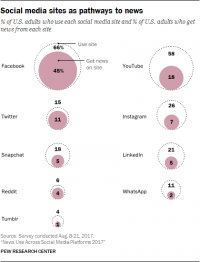This Is What Social Media Superstars Can Teach You About Building Influence
Social media influencers are having a moment. Those who have successfully built engaged communities are turning them into businesses and working with marketers to promote their brands.
The key to their success is clear: their influence. When they share or speak out on something, they’ve built enough of a reputation that people listen, engage, and often believe what they have to say. And many of us try to build that kind of influence in the office. Learning a few lessons from real social media influencers might do the trick.
Start With Your Strengths
In the workplace, you need to find where your strengths and the needs of the organization or your audience align, and then make that known, says entrepreneur, personal trainer, and influencer Jillian Michaels. It might be tempting to try to make people like you or to be everything to everyone, but that turns you into “plain vanilla,” and you don’t stand out in a way that builds influence, she says.
“I learned a long time ago that you can’t be everything to everyone. There are 7 billion people on the planet, and enough of them who will respond to my voice and my uniqueness to build a very healthy, happy business,” Michaels says. So figure out the areas where your strengths shine and where your expertise can make a difference, which will give you a solid base from which to build your influence.
Focus On Audience Quality, Not Size
While some social media influencers reach millions, others can be just as effective with a much smaller but more engaged following, says Rakia Reynolds, owner of Skai Blue Media, a public relations company that helps brands find and engage the right voices to represent their brands. Reynolds is also a social media influencer herself, representing brands like Dell and others.
Reynolds says influence goes back to the basics: Understand your audience and deliver value. That holds true whether you’re delivering information to an audience on LinkedIn, choosing the best photos for Instagram, or proving yourself in an office setting. Understand the power centers in your office and make sure that the message about your contributions and abilities are reaching them in ways that matter to them, she says.
Communicate And Curate
“Social media influencers are, by the nature of the work, good communicators,” says millennial expert and influencer Lindsey Pollak, author of Becoming the Boss: New Rules for the Next Generation of Leaders. Whether they’re using text, images, or even emojis, they communicate in ways that generate a response, she says. Knowing when to use a conversation, PowerPoint presentation, or an email to best communicate to whoever the audience is—customers, management, employees—is more important than ever before, she says. “I think social media influencers spend a lot of time thinking about that,” she says.
Similarly, becoming a go-to source for information—the basis of many social media influencers’ popularity—is another way to fast-track influence. Reynolds says.
Be Authentic But Aspirational
While the word “authentic” is overused, Michaels says it’s a critical part of building influence. Other people won’t take you seriously if they don’t think you’re being honest about what you believe or how you act. Sharing some personal information and showing vulnerability at times can go a long way toward building relationships. “I don’t love shots of wheatgrass—no! But I do it, and it’s because it provides me with something that’s more important in the long run,” she says.
“And that relatability happens when someone goes, ‘Oh, wow. She doesn’t like it either. Oh, wow, she’d prefer to eat that, too. They see your humanity and relate to it,” Michaels says. In an office setting, being fake or boastful is a quick way to get people to tune you out, which hurts your influence.
At the same time, there’s a fine line between showing humanity and vulnerability and oversharing. Being an endless source of sad news or complaining doesn’t help you gain influence, either. Michaels says she’s not the right trainer for people who are offended by the “f-word,” but she tries not to post anything that’s aggressive toward other people, hostile, or “that spreads negativity toward humanity.”
Pay Attention To What’s Working
Monitoring the communication that gets the most clicks and comments can give you important insight into what’s resonating with your audience, Pollak says. Measuring how they respond to different material can help you deliver more value to them and, at the same time, increase your reach and influence.
Similarly, feedback from colleagues, supervisors, or mentors can give you insight into your own strengths, value, and performance, Pollak says. “Then, instead of changing or reacting [to situations in the workplace], improve based on those metrics,” she says. You don’t want to “change with the wind,” she says. “However, you want to know that what you’re doing works, and be flexible in your style if the outcomes are not what you want them to be,” she says.
Choose Consistency, Not Predictability
When people check a social media influencer’s page or posts, they want to know what to expect. They may know how the person makes them feel. They may be looking for information. But if they visit a few times and they don’t get what they expect—perhaps the content hasn’t been updated lately or it’s poor quality or stale—the trust between influencer and audience is broken and they likely won’t be back. In the workplace, being reliable and consistently delivering what is expected of you is important in building influence as well, she says.
At the same time, don’t be so predictable that you’re boring. A little risk can be a good thing, Pollak says.
“There’s sort of an understanding now that the old way is just not going to cut it, so you have to be willing to take some chances to succeed,” she says. “Social media influencers are really good at that, and I admire that willingness to just try new stuff.”
Fast Company , Read Full Story
(7)







